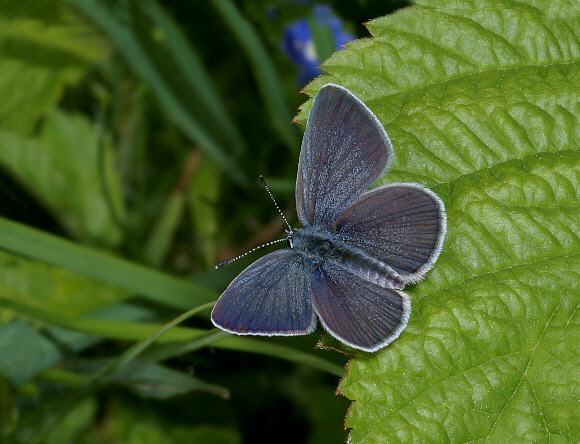 Small Blue Cupido minimus, male, Martin Down, Hampshire – Adrian Hoskins
Small Blue Cupido minimus, male, Martin Down, Hampshire – Adrian Hoskins
Introduction
Speckled in metallic powder blue on a sooty ground colour, the male of this delightful butterfly is the smallest in the UK, and one of the smallest in Europe. The female is slightly larger and lacks the blue speckling. On the underside both sexes are silvery with tiny black spots, and when seen in flight the butterflies have a very silvery appearance, like tiny spinning coins.
It is a widespread and common species in Europe, where it occurs from the Cantabrian mountains of northern Spain, eastward across Europe, and thence across temperate Asia to Mongolia and Amur.In mainland Europe there are 3 other members of the genus Cupido, with which the Small Blue can very easily be confused. Males of C. osiris, which occur in the same habitats as minimus, have deep blue uppersides, but the females are dark grey, peppered with greyish-blue scales like the male of minimus. The other 2 species, lorquinii and carswelli, occur only in southern Spain, where minimus is absent.
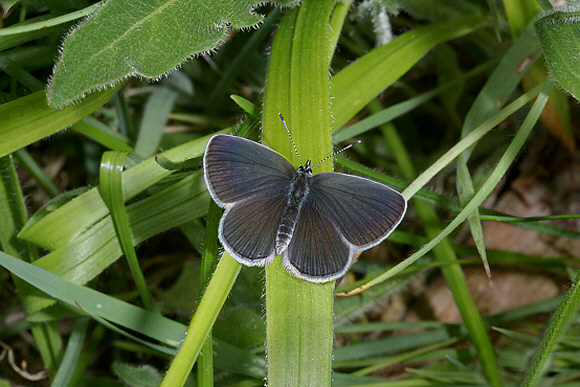 Small Blue Cupido minimus, female, Martin Down, Hampshire – Adrian Hoskins
Small Blue Cupido minimus, female, Martin Down, Hampshire – Adrian Hoskins
Habitats
The butterfly is widely distributed across southern England, but extremely localised, and confined to small corners of its habitats where the foodplant grows in profusion. Typical sites include sheltered, ungrazed or lightly grazed habitats in old chalk or limestone quarries, calcareous sand dunes, south facing grassland slopes, cliffs and limestone pavements. Colonies also exist on steep, well-drained road and rail embankments. In Europe the butterflies also breed in limestone gorges, sub-alpine hay meadows and grassland / woodland mosaics.
All sites are characterised by the presence of kidney vetch Anthyllis vulneraria, growing amongst sparse fine grasses, typically at the edge of paths or on eroding banks. There also need to be tall grasses or bushes growing nearby, where the adult butterflies can find shelter overnight or during periods of inclement weather. The vast majority of colonies comprise of only a couple of dozen insects, although there are a small number of sites where populations run into a few hundreds.
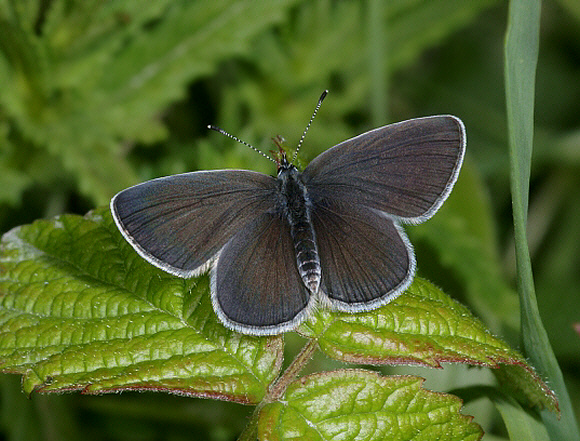 Small Blue Cupido minimus, female, Martin Down, Hampshire – Adrian Hoskins
Small Blue Cupido minimus, female, Martin Down, Hampshire – Adrian Hoskins
Lifecycle
The main emergence of Small Blues is in late May and June, sometimes running into early July and overlapping with the 2nd brood, which flies from mid July until late August. This 2nd brood however is only partial, producing only about 5% of the numbers occuring in the spring brood.
The butterflies lay their pale greyish-blue eggs singly on the flowers of kidney vetch, at the base of the calyx. They then rub their abdomens all over the flower head, marking them with scent to deter other females from laying on the same flower. A single flower head can only support one larva, and if two or more find themselves on the same flower head they become cannibalistic. Unfortunately the scent wears off after a day or two however, so sometimes several eggs can be found together, probably laid singly by different females, but only one of the resulting larvae will survive.
The eggs hatch in about 10 days, and the tiny larva immediately burrows into the flower where it feeds on the anthers and seeds. When it is older and too big to feed inside the flower the caterpillar rests on the calyx tube, facing downwards, and makes a hole at the base, through which it feeds on the tissue of the developing seed.
In common with most Lycaenid species, caterpillars of the Small Blue possess ant-attracting organs. Their relationship with ants is probably beneficial ( ants would deter other insects from attacking the larvae ), but there is no symbiotic interdependence. This is demonstrated by observing that while most European populations of minimus larvae are attended by ants e.g. Lasius niger and Myrmica rubra, there are no records of this in the UK.
The fully grown larva leaves the foodplant and settles into a crevice in the ground, where it spends the winter. Most larvae pupate the following May, and produce butterflies in June, but some larvae remain in diapause for up to 15 months, emerging in August of the following year. It is in fact quite possible that the apparent “2nd brood” adults may be nothing more than a delayed emergence of a single brood.
The slightly hirsute chrysalis, which is greyish-buff and spotted with black, is formed at ground level, hidden in a crevice, or amongst leaf litter. Like the larva, the pupa can secrete a sugary substance that is attractive to ants, and it is probable that it in both the UK and Europe the pupae are attended by ants and probably buried and protected by them until the adult butterflies emerge.
The pupae of many Blues, Hairstreaks and Coppers possess microscopic ridges on the abdomen which can be rubbed as the pupa wriggles, to produce a stridulating squeak. This may help the ants to locate the pupa, but it is more likely that the sound is used to appease the ants and deter them from eating it. The pupal stage lasts about 2 weeks.
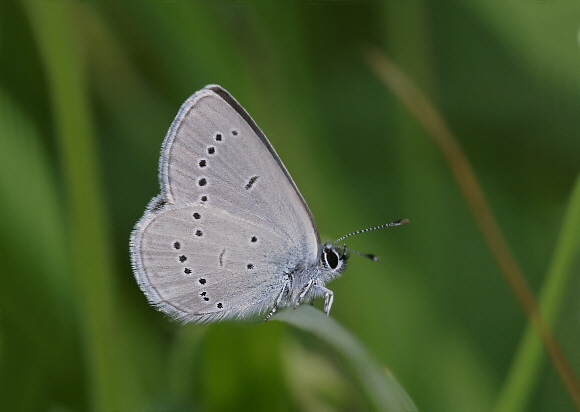 Small Blue Cupido minimus, male, Portsdown Hill, Hampshire – Adrian Hoskins
Small Blue Cupido minimus, male, Portsdown Hill, Hampshire – Adrian Hoskins
Adult behaviour
The butterflies are usually found in small groups of a dozen or so, although at some sites I have found up to 200 at roost on grasses in sheltered depressions.
The males spend most of their time basking with wings half-open, on grass blades or on the foliage of bramble and other low plants where they await passing butterflies. They will intercept other small species including Brown Argus and Common Blues, but ignore larger species.
Periodically several butterflies will erupt into flight, and during male-male encounters a very brief sortie takes place, after which each male returns to another perching place. When virgin females are intercepted copulation takes place almost instantaneously, but when gravid females are intercepted they immediately settle deep amongst grasses, where they hide until the male flies away.
Copulated pairs can often be found sitting amongst lush foliage in depressions or ditches close to the breeding sites. After separating the males remain at their territories to await further females, but the mated females move away, dispersing onto more open areas to seek egg-laying sites.
Both sexes nectar mainly on leguminous plants including kidney vetch, bird’s foot trefoil, horseshoe vetch and black medick, but will also imbibe dissolved minerals from animal dung – I once found a group of over 50 Small Blues feeding at a very dry cowpat in the French Alps, and have often found singletons or small groups on animal faeces in the UK. In Vanoise national park in the French Alps I have also found large aggregations imbibing dissolved minerals from mud at the sides of streams.
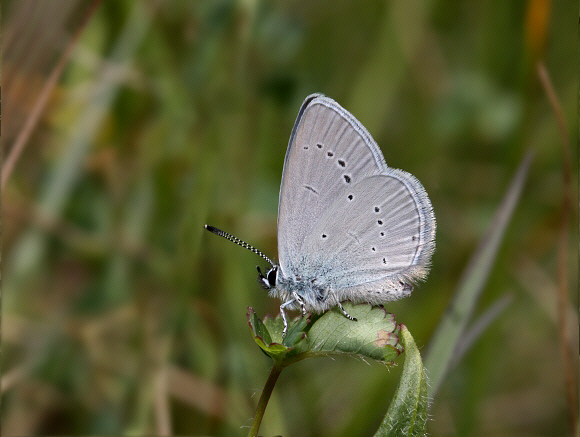 Small Blue Cupido minimus, male, Hod Hill, Dorset – Adrian Hoskins
Small Blue Cupido minimus, male, Hod Hill, Dorset – Adrian Hoskins
